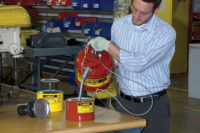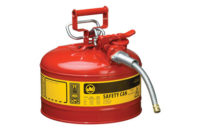
Slips, trips and falls are one of the leading causes of workplace accidents each year. Many factors contribute to these accidents, including poorly maintained floors, the use of inappropriate products for floor care, cords or cables stretched across walkways, failure to clean up spills, and ignoring methods and equipment to avoid spills in the first place.
Spills and leaks can and must be controlled. Drums and intermediate bulk containers (IBCs) can be protected in storage using the appropriate containment device. Select from steel or poly spill control pallets, accumulation centers, collection centers, or possibly outdoor containment sheds. Sheds are an option when indoor storage is not required for workplace efficiency or convenience.
Choose the containment device size that best complements your primary storage. For example, spill control pallets are available in capacities to store one, two, three or four drums. Square or linear designs are available. Select the style that works in your storage area. IBC spill pallets are also available if needed. Drums and IBCs must be inspected regularly for their integrity. If a leak is found, transfer the contents immediately and place the damaged drum in an overpack/salvage drum.
Spills are likely to occur during the dispensing of liquids. Use approved self-closing faucets to minimize these spills. Swivel connection faucets will prevent leaks caused by over-tightening. Spill trays placed under the faucets will catch drips. When dispensing from vertically stored drums, use approved transfer pumps. This checklist can help you control spills during storage, transfer and use of liquids in the workplace:
Slips, trips and falls are one of the leading causes of workplace accidents each year. Many factors contribute to these accidents, including poorly maintained floors, the use of inappropriate products for floor care, cords or cables stretched across walkways, failure to clean up spills, and ignoring methods and equipment to avoid spills in the first place.
Spills and leaks can and must be controlled. Drums and intermediate bulk containers (IBCs) can be protected in storage using the appropriate containment device. Select from steel or poly spill control pallets, accumulation centers, collection centers, or possibly outdoor containment sheds. Sheds are an option when indoor storage is not required for workplace efficiency or convenience.
Choose the containment device size that best complements your primary storage. For example, spill control pallets are available in capacities to store one, two, three or four drums. Square or linear designs are available. Select the style that works in your storage area. IBC spill pallets are also available if needed. Drums and IBCs must be inspected regularly for their integrity. If a leak is found, transfer the contents immediately and place the damaged drum in an overpack/salvage drum.
Spills are likely to occur during the dispensing of liquids. Use approved self-closing faucets to minimize these spills. Swivel connection faucets will prevent leaks caused by over-tightening. Spill trays placed under the faucets will catch drips. When dispensing from vertically stored drums, use approved transfer pumps. This checklist can help you control spills during storage, transfer and use of liquids in the workplace:
STORAGE of hazardous drums
- Spill control pallets
- Accumulation centers
- Steel spill pallets
- Collection centers (double drum and single drum)
- Outdoor drum sheds
-
IBC indoor pallet and IBC outdoor shed
- a. 30- and 55-gallon drums of liquids stored on EPA-compliant spill control pallets
- b. Pallets located away from hot work, heat or other ignition sources
- c. Drums inspected for damage/leaks regularly and pallet sumps checked and cleaned promptly
- d. Spill pallets being used for safe waste accumulation into drums, pails or other containers
- e. Pumping or dispensing operations from drums on spill control pallets to catch drips or spills
- f. Connectable, custom configured low profile accumulation centers in place to collect leaks from used batteries, small equipment, pails or drums
- g. Small quantity storage of one drum requiring portability to another location
- h. Intermediate bulk container stored on IBC pallet for large scale spill protection
- i. Spill collection center being used for outdoor small quantity storage of up to two drums
- j. Drum sheds in use for protected outdoor storage of up to four 55-gallon drums or other containers
- k. IBC storage shed used outdoors for 275-330 gallon intermediate bulk containers
TRANSFER operation when using drums
- Drum caddy
- Spill control funnels
-
Overpack/salvage drums
- a. Drum caddy used for spill controlled dispensing from a horizontally stored drum
- b. Drum caddy used for easy movement of heavy drums to another area in the facility
- c. Portable, one-drum vertical storage station with dolly used when relocation is desired
- d. Low profile funnels in place on drums for quick liquid collection or passive draining of oil cans
- e. Damaged or waste drums placed in overpack/salvage drum per United Nations (UN)/Department of Transportation (DOT) transport regulations
- f. Soiled sorbents properly collected and packed in overpack/salvage drum
- g. Overpack/salvage drum used for emergency response/contamination site cleanup
USE activities with containers, equipment, supplies and drums
- Drum management system
-
Spill trays
- a. Drum management system in place for horizontally stored drums used in dispensing operation
- b. Horizontally stored drums equipped with self-closing faucets and pressure relief vents
- c. Spill trays in place under drums stored on open racks
- d. Battery leaks captured in spill trays
- e. Washing pails staged on spill trays
- f. Spill trays used for small mixing operation
- g. Oily small equipment parts stored on spill trays
- h. Paint cans and supplies stored on spill trays preventing paint marks on flooring

